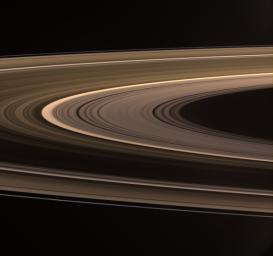
|
Rings Aglow
- Click the image above for a larger view
- Full-Res JPEG (1022 x 957) (68.8 kB)
- Full-Res TIFF (1022 x 957) (2.9 MB)
Caption:
Saturn's softly glowing rings shine in scattered sunlight.
The B ring presents a remarkable difference in brightness between the near and far arms (bottom and top of the image, respectively). The strong variation in brightness could be due to the presence of wake-like features in the B ring.
See PIA08389 for a labeled Cassini map of the rings.
This view looks toward the unilluminated side of the rings from about 5 degrees above the ringplane. Images taken using red, green and blue spectral filters were combined to create this natural color view. The images were acquired at a distance of approximately 574,000 kilometers (357,000 miles) from Saturn. At the center of the image, the Sun-ring-spacecraft, or phase, angle is 114 degrees, and the image scale is 34 kilometers (21 miles) per pixel in the radial, or outward from Saturn, direction.
Background Info:
The Cassini-Huygens mission is a cooperative project of NASA, the European Space Agency and the Italian Space Agency. The Jet Propulsion Laboratory, a division of the California Institute of Technology in Pasadena, manages the mission for NASA's Science Mission Directorate, Washington, D.C. The Cassini orbiter and its two onboard cameras were designed, developed and assembled at JPL. The imaging operations center is based at the Space Science Institute in Boulder, Colo.
For more information about the Cassini-Huygens mission visit http://saturn.jpl.nasa.gov/home/index.cfm . The Cassini imaging team homepage is at http://ciclops.org .
Cataloging Keywords:
| Name | Value | Additional Values |
|---|---|---|
| Target | Saturn | B Ring, Saturn Rings |
| System | Saturn | |
| Target Type | Planet | Ring |
| Mission | Cassini-Huygens | |
| Instrument Host | Cassini Orbiter | |
| Host Type | Orbiter | |
| Instrument | Imaging Science Subsystem (ISS) | |
| Detector | ||
| Extra Keywords | Color, Map | |
| Acquisition Date | ||
| Release Date | 2008-03-18 | |
| Date in Caption | ||
| Image Credit | NASA/JPL/Space Science Institute | |
| Source | photojournal.jpl.nasa.gov/catalog/PIA09860 | |
| Identifier | PIA09860 | |
